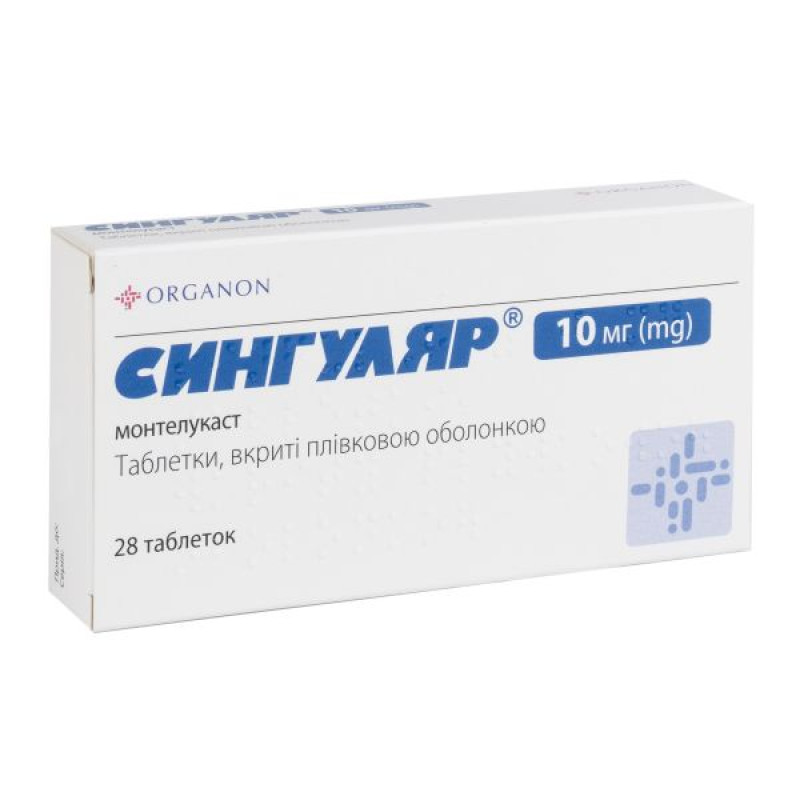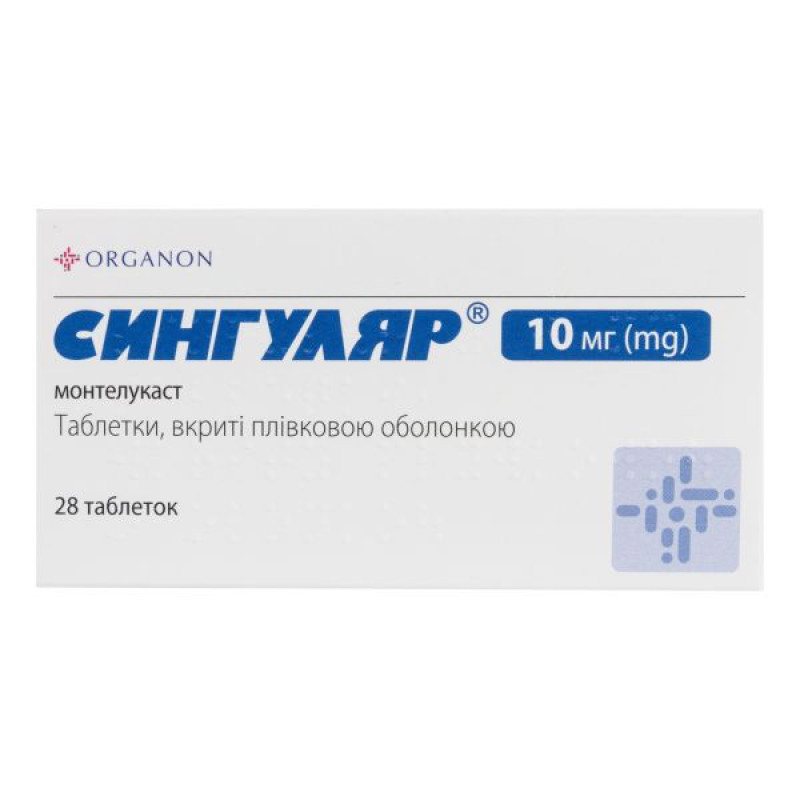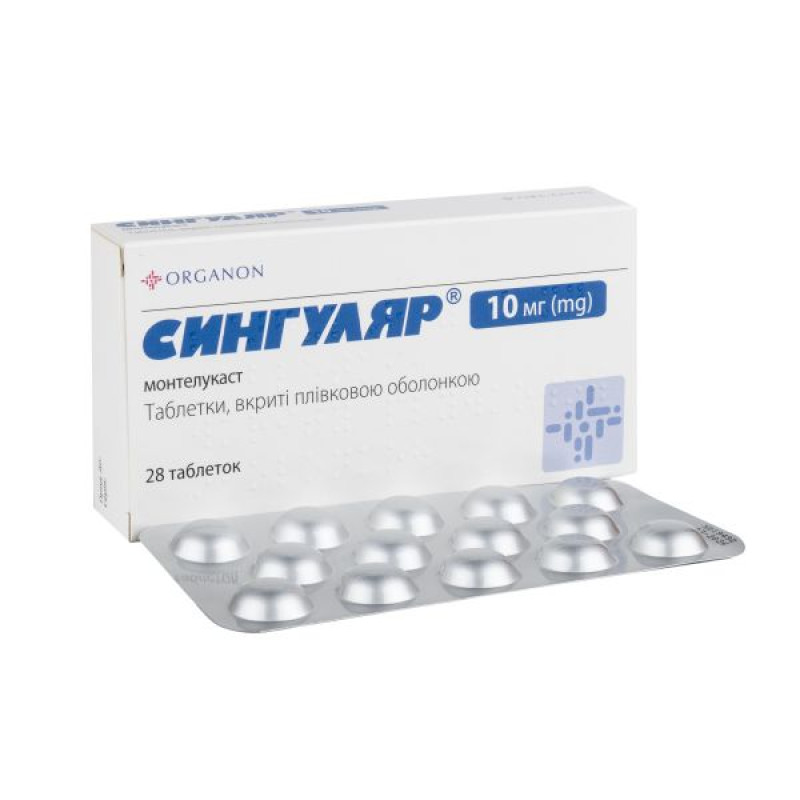Singulair film-coated tablets 10 mg blister No. 28

Instructions for Singulair film-coated tablets 10 mg blister No. 28
Composition
active ingredient: montelukast;
1 film-coated tablet contains montelukast sodium 10.4 mg (equivalent to montelukast 10 mg);
excipients: hydroxypropylcellulose, microcrystalline cellulose, lactose monohydrate, croscarmellose sodium, magnesium stearate;
Tablet coating: hydroxypropylcellulose, methylhydroxypropylcellulose, titanium dioxide (E 171), red iron oxide (E 172), yellow iron oxide (E 172), carnauba wax.
Dosage form
Film-coated tablets.
Main physicochemical properties: beige, square tablets with rounded edges, film-coated, with the pressed inscription "SINGULAIR" on one side and "MSD 117" on the other.
Pharmacotherapeutic group
Means for systemic use in obstructive airway diseases. Leukotriene receptor blockers.
ATX code R03D C03.
Pharmacological properties
Pharmacodynamics
Cysteinyl leukotrienes (LTC4, LTD4, LTE4) are potent inflammatory eicosanoids secreted by a variety of cells, including mast cells and eosinophils. These important pro-asthmatic mediators bind to cysteinyl leukotriene receptors (CysLT). The CysLT type 1 receptor (CysLT1) is found in the human airways (including airway smooth muscle cells and airway macrophages) as well as on other pro-inflammatory cells (including eosinophils and certain myeloid stem cells). The presence of CysLT receptors correlates with the pathophysiology of asthma and allergic rhinitis. In asthma, leukotriene-mediated effects include bronchoconstriction, mucus secretion, vascular permeability, and eosinophilia. In allergic rhinitis, CysLT protein is released from the nasal mucosa after allergen exposure in both early and late-type reactions, and this is accompanied by symptoms of allergic rhinitis. According to studies, intranasal administration of CysLT resulted in increased nasal airway resistance and increased symptoms of nasal congestion.
Montelukast is an orally administered active compound that binds with high selectivity and affinity to CysLT1 receptors. In clinical studies, montelukast has been shown to inhibit bronchospasm following inhalation of 5 mg LTD4. Bronchodilation was observed within 2 hours of oral administration and was additive to that induced by β-agonists. Montelukast treatment inhibited both the early and late phases of antigen-induced bronchoconstriction. Montelukast reduces peripheral blood eosinophil counts in adult and pediatric patients compared with placebo. In a separate study, montelukast significantly reduced airway (sputum) and peripheral blood eosinophil counts and improved clinical asthma control.
In studies in adults, montelukast 10 mg once daily demonstrated significant improvements compared with placebo in morning FEV1 (change from baseline of 10.4% and 2.7%, respectively), morning peak expiratory flow rate (PEFV) (change from baseline of 24.5 L/min and 3.3 L/min, respectively), and a significant reduction in total β-agonist use (change from baseline of -26.1% and -4.6%, respectively). Improvements in patient-reported daytime and night-time asthma symptoms were significantly greater than placebo.
A clinical trial was conducted to evaluate montelukast as a symptomatic treatment for seasonal allergic rhinitis in patients 15 years of age and older with asthma and comorbid seasonal allergic rhinitis. This trial demonstrated that montelukast tablets, when administered at a dose of 10 mg once daily, demonstrated statistically significant improvements in the average daily rhinitis symptom score compared to placebo. The average daily rhinitis symptom score is the average of daytime nasal symptoms (average nasal congestion, rhinorrhea, sneezing, nasal itching) and nighttime nasal symptoms (average nasal congestion upon awakening, difficulty falling asleep, and number of nighttime awakenings). Compared with placebo, patients and physicians reported significantly better overall ratings of allergic rhinitis treatment. The efficacy of this treatment in asthma was not the primary objective of this study.
In an 8-week study in children aged 6 to 14 years, montelukast 5 mg once daily compared with placebo significantly improved respiratory function (change from baseline in FEV1: 8.71% vs. 4.16%, change in morning PSV: 27.9 L/min vs. 17.8 L/min) and reduced the frequency of as-needed β-agonist use (change from baseline by -11.7% vs. +8.2%).
Significant reduction in exercise-induced bronchospasm (EIB) was demonstrated in a 12-week study in adults (peak FEV1 decline 22.33% for montelukast vs. 32.40% for placebo; time to recover to within 5% of baseline FEV1 44.22 min vs. 60.64 min). This effect was observed throughout the 12-week study period. Reduction in EIB was also demonstrated in a short-term study in children aged 6 to 14 years (peak FEV1 decline 18.27% vs. 26.11%; time to recover to within 5% of baseline FEV1 17.76 min vs. 27.98 min). The effect in both studies was demonstrated at the end of the once-daily dosing interval.
In aspirin-sensitive patients receiving current inhaled and/or oral corticosteroid therapy, treatment with montelukast compared with placebo resulted in significantly improved asthma control (change from baseline in FEV1 of 8.55% vs. -1.74% and change from baseline in reduction in total β-agonist use of -27.78% vs. 2.09%).
Pharmacokinetics
Absorption
Montelukast is rapidly absorbed after oral administration. After administration of 10 mg film-coated tablets to adults in the fasted state, mean peak plasma concentrations (Cmax) were achieved at 3 hours (Tmax). Mean oral bioavailability was 64%. Oral bioavailability and Cmax were not affected by food intake. Safety and efficacy were demonstrated in clinical studies with 10 mg film-coated tablets administered without regard to mealtime.
For the 5 mg chewable tablet, Cmax in adults was achieved 2 hours after administration in the fasted state. The mean oral bioavailability is 73% and decreases to 63% when taken with a standard meal.
Distribution
Montelukast is more than 99% bound to plasma proteins. The steady-state volume of distribution of montelukast averages 8 to 11 liters. In studies in rats with radiolabeled montelukast, passage across the blood-brain barrier was minimal. In addition, radiolabeled material concentrations in all other tissues were also minimal 24 hours after dosing.
Metabolism
Montelukast is extensively metabolized. Steady-state plasma concentrations of montelukast metabolites were not determined in studies using therapeutic doses in adults and pediatric patients.
Cytochrome P450 2C8 is the major enzyme in the metabolism of montelukast. In addition, cytochromes CYP 3A4 and 2C9 play a minor role in the metabolism of montelukast, although itraconazole (a CYP 3A4 inhibitor) did not alter the pharmacokinetics of montelukast in healthy volunteers given 10 mg of montelukast daily. In vitro studies using human liver microsomes indicate that therapeutic plasma concentrations of montelukast do not inhibit cytochromes P450 3A4, 2C9, 1A2, 2A6, 2C19, and 2D6. The contribution of metabolites to the therapeutic effects of montelukast is minimal.
Breeding
The plasma clearance of montelukast in healthy adult volunteers averages 45 mL/min. After oral administration of radiolabeled montelukast, 86% is excreted in the feces within 5 days and less than 0.2% in the urine. This, together with the oral bioavailability of montelukast, indicates that montelukast and its metabolites are almost entirely excreted in the bile.
Pharmacokinetics in different patient groups
A decrease in plasma theophylline concentrations has been observed at high doses of montelukast (20 and 60 times the recommended adult dose). This effect is not observed at the recommended dose of 10 mg once daily.
Indication
As an add-on treatment for bronchial asthma in patients with mild to moderate persistent asthma inadequately controlled with inhaled corticosteroids, and when asthma is not adequately controlled with short-acting β-adrenergic agonists used as needed. In patients with asthma taking Singulair®, this drug also relieves symptoms of seasonal allergic rhinitis.
Prevention of asthma, the dominant component of which is exercise-induced bronchospasm.
Relief of symptoms of seasonal and perennial allergic rhinitis. The risks of psychoneurological symptoms in patients with allergic rhinitis may outweigh the benefits of using Singulair®, so Singulair® should be used as a reserve drug in patients with inadequate response to or intolerance to alternative therapy.
Contraindication
Hypersensitivity to any of the components of the drug. Children under 15 years of age (for a dose of 10 mg).
Interaction with other medicinal products and other types of interactions
Singulair® can be administered with other drugs commonly used for the prevention or long-term treatment of asthma. In drug-drug interaction studies, the recommended clinical dose of montelukast had no clinically important effect on the pharmacokinetics of the following drugs: theophylline, prednisone, prednisolone, oral contraceptives (ethinyl estradiol/norethindrone 35/1), terfenadine, digoxin, and warfarin.
In patients receiving concomitant phenobarbital, the area under the concentration-time curve (AUC) for montelukast was decreased by approximately 40%. Since montelukast is metabolized by CYP3A4, 2C8, and 2C9, caution should be exercised, especially in children, when montelukast is administered concomitantly with inducers of CYP3A4, 2C8, and 2C9, such as phenytoin, phenobarbital, and rifampicin.
In vitro studies have shown that montelukast is a potent inhibitor of CYP 2C8. However, data from a clinical drug interaction study involving montelukast and rosiglitazone (a marker substrate; a drug metabolized by CYP 2C8) have shown that montelukast is not an inhibitor of CYP 2C8 in vivo. Therefore, montelukast does not significantly affect the metabolism of drugs metabolized by this enzyme (e.g., paclitaxel, rosiglitazone, and repaglinide).
In vitro studies have shown that montelukast is a substrate of CYP 2C8 and, to a lesser extent, 2C9 and 3A4. In a clinical drug interaction study with montelukast and gemfibrozil (an inhibitor of CYP 2C8 and 2C9), gemfibrozil increased the systemic exposure of montelukast by 4.4-fold. No dose adjustment of montelukast is required when used concomitantly with gemfibrozil or other potent inhibitors of CYP 2C8, but the physician should consider the increased risk of adverse reactions.
Based on in vitro studies, no clinically significant interactions are expected with less potent CYP 2C8 inhibitors (e.g. trimethoprim). Co-administration of montelukast with itraconazole, a potent CYP 3A4 inhibitor, did not result in a significant increase in systemic exposure to montelukast.
Application features
Patients should be advised that oral Singulair® should never be used to treat acute asthma attacks and that they should always carry appropriate rescue medication with them. In the event of an acute attack, a short-acting inhaled β-agonist should be used. Patients should consult their physician as soon as possible if they require more short-acting β-agonist than usual.
Montelukast should not be abruptly substituted for inhaled or oral corticosteroid therapy.
There is no evidence to suggest that the dose of oral corticosteroids can be reduced when montelukast is co-administered.
Neuropsychiatric reactions, such as behavioral changes, depression, and suicidality, have been reported in patients of all ages receiving montelukast (see Adverse Reactions). The symptoms may be severe and may persist if treatment is not discontinued. Therefore, montelukast should be discontinued if neuropsychiatric symptoms occur. Patients and/or caregivers should be alert to neuropsychological reactions and report any behavioral changes to their physician. | ||
| Organ system classes | Adult patients and children over 15 years old (two 12-week studies; n=795) |
| Nervous system disorders | Headache |
| Gastrointestinal (GI) disorders | Abdominal pain |
In clinical studies with prolonged treatment of a small number of adult patients for 2 years and children aged 6 to 14 years for 12 months, the safety profile did not change.
Post-marketing period
Adverse reactions reported during the post-marketing period are listed by system organ class and by special terms in Table 2. The frequencies are based on data from relevant clinical trials.
Table 2
| Organ system class | Adverse reactions | Frequency* |
| Infections and infestations | Upper respiratory tract infections† | very often |
| Blood and lymphatic system disorders | Tendency to increase bleeding | rarely |
| Thrombocytopenia | very rarely | |
| Immune system disorders | Hypersensitivity reactions, including anaphylaxis | infrequently |
| Eosinophilic infiltration of the liver | very rarely | |
| Mental disorders | Sleep disturbances, including nightmares, insomnia, somnambulism, anxiety, agitation including aggressive behavior or hostility, depression, psychomotor hyperactivity (including irritability, restlessness, tremor§) | infrequently |
| Attention deficit, memory impairment, tics | rarely | |
| Hallucinations, disorientation, suicidal thoughts and behavior (suicidality), obsessive-compulsive disorder, dysphemia | very rarely | |
| Nervous system disorders | Dizziness, lethargy, paresthesia/hypoesthesia, convulsions | infrequently |
| Cardiac disorders | Palpitation | rarely |
| Respiratory, thoracic and mediastinal disorders | Nosebleed | infrequently |
| Churg-Strauss syndrome (see section "Special warnings and precautions for use"), pulmonary eosinophilia | very rarely | |
| Gastrointestinal disorders | Diarrhea‡, nausea‡, vomiting‡ | often |
| Dry mouth, dyspepsia | infrequently | |
| Hepatobiliary system disorders | Increased serum transaminase levels (ALT, AST) | often |
| Hepatitis (including cholestatic, hepatocellular, and mixed liver disease) | very rarely | |
| Skin and subcutaneous tissue disorders | Rash‡ | often |
| Hematoma, hives, itching | infrequently | |
| Angioedema | rarely | |
| Erythema nodosum, erythema multiforme | very rarely | |
| Musculoskeletal and connective tissue disorders | Arthralgia, myalgia, including muscle cramps | infrequently |
| Renal and urinary disorders | Enuresis in children | infrequently |
| General disorders and adverse reactions caused by taking the drug | Pyrexia‡ | often |
| Asthenia/fatigue, malaise, edema | infrequently | |
*Frequency is defined according to the frequency of reports in the clinical trial database: very common (≥ 1/10), common (≥ 1/100 to < 1/10), uncommon (≥ 1/1,000 to < 1/100), rare (≥ 1/10,000 to < 1/1,000), very rare (< 1/10,000). †This adverse reaction was reported with a frequency of “very common” in patients treated with montelukast, as well as in patients treated with placebo, during clinical trials. ‡This adverse reaction was reported with a frequency of “common” in patients treated with montelukast as well as in patients treated with placebo in clinical trials. §Rarely. | ||
Expiration date
3 years.
Do not use the medicine after the expiry date stated on the packaging.
Storage conditions
Store in the original packaging at a temperature not exceeding 30 °C.
Keep out of reach of children.
Packaging
14 tablets in a blister. 2 blisters in a cardboard box.
Vacation category
According to the recipe.
Producer
Merck Sharp & Doom B.V., Netherlands.
Organon Heist bv, Belgium.
Vaarderweg 39, 2031 BN Haarlem, Netherlands.
Industrial Park 30, 2220, Heist-op-den-Berg, Belgium.
There are no reviews for this product.
There are no reviews for this product, be the first to leave your review.
No questions about this product, be the first and ask your question.








